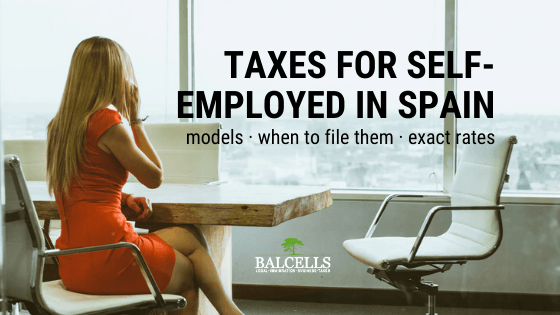The idea sounds promising: becoming a self-employed worker while enjoying the amazing life Spain offers. No boss, no fixed schedule. You can organize yourself to devote time to experience the Spanish lifestyle. But then, something bad happens: taxes. And self-employed taxes can be a real headache. Nevertheless, this article tries to be the solution. We will go over all the taxes a freelancer must pay in Spain. We will carefully analyze how to file them, when to submit your tax declarations, and the exact rates you should pay. Including all the deductions you can benefit from that will allow you to save money!
Which are the taxes paid by freelancers or self-employed in Spain?
Basically, the freelance tax corresponds to income tax and VAT. Nevertheless, you will also have extra liabilities, like social security contributions. Let’s explore that.
If you spend over 183 days per year in Spain, you become what is called a tax resident.
As you can find in our guide on all the taxes any foreigner must pay in Spain, being a tax resident means that you must pay taxes on your worldwide income. This includes the income you generate in Spain and in any other country in the world.
Hence, you will need to follow the Spanish tax year and the obligations it poses.
The tax year in Spain corresponds to the calendar year, from January to December. In that sense, every self-employed worker must file quarterly tax returns, every 3 months. this means filing taxes in January, April, July, and October. Besides, the freelance must also do extra tax declarations once per year.
But what exactly is the self-employed individual declaring through his tax returns? The following taxes:
- Income tax, levied on the incomes you generate.
- VAT, the 21% extra fee that you will need to add on top of your invoices (adding it to your service fee o product price).
- And, in case you operate as a company, you will then need to pay corporate tax. In this case, the exact tax is a flat rate of 25%. Nevertheless, during the first year in which you obtain a profit as a company and the next one, you’ll just pay a reduced 15%.
Finally, there is an extra payment that raises special interest that we will also cover in this article. Even though we are not talking about a tax, it’s a monthly contribution that every freelance is liable while in Spain: contributions to social security.
Let’s explore each of them extensively.
Freelance income tax
This is the most important tax any self-employed must pay: the income tax.
You can find out complete information about income tax in this guide, but here we will cover the basics that affect “autónomos”.
What does the freelance income tax consist of?
Quarterly, any self-employed must compute income generated and deduct all the expenses registered. You will pay 20% on that net amount. And no matter the amount of income you generated or the type of industry or profession you are in, you will pay this fixed 20%.
But the most important thing to understand here is that this is a payment on account.
In fact, the income tax for self-employed workers is a subjective tax; meaning that it varies according to the specific case. Then, when will you recover the amount you paid extra or pay what you did not pay on the quarter?
On your annual income tax return.
Every year, between May and June, you need to file an income tax return. It will be through this procedure when the correct and exact rate according to your case will be applied.
If you paid more than what you should during your quarter declarations (meaning that the real rate was below 20%), then you will be entitled to get a refund. But if you paid less than you should (the actual rate had to be higher than 20%), then you must bonify the difference.
Furthermore, through this declaration you will also adjust all the payments on account that you have been registering throughout the year. Don’t worry: in a second we will explore which are those.
Which are the expenses you can deduct?
This is, for sure, one of the sections that should interest you the most. Because you can deduct a great number of expenses from your tax returns. This means that any amount you are able to deduce corresponds to an amount you will save taxes on.
Nevertheless, there are two important caveats to be made here.
First of all, the general rule is clear. Any expense that you can deduct must be entirely related to your economic activity as a freelance. This means that you cannot eliminate from your income tax payments an amount of money that cannot be used to generate extra incomes through your day to day operations. The crucial part here would be to properly justify them.
Secondly, each case here is particular and must be studied carefully and independently. We will now provide a set of general cases that you can benefit from. Nevertheless, it is always required to analyze the specific case and see if 1. the general rule applies and 2. if there are any extra allowance or bonification you can benefit from.
We will start talking about two cases in which you can deduct part of the expense, and then jump into those costs that you can fully deduct.
Supply costs
If you are working as a freelance from home, you can deduct 30% of the utilities or supply costs related to your activity. We are talking about your monthly water, gas, phone, internet, and/or electricity bills.
Nevertheless, this 30% will be just applied to the proportional part of those bills that are related to the activity. What does this mean? Let’s see how this deduction works.
First of all, once you will out the model 036 or 037 when registering as a self-employed individual, you must specify up to which degree your household is devoted to your daily business operations.
So, for instance, let’s say that you dedicate one of your house rooms to work as your office. And that room represents 25% of your total house space in square meters.
Then, you can deduct 30% of the monthly utility bill corresponding to that room, being 25% of the total house. So, if the electricity bill was 100€ per month, you could deduct 100€ x 25% x 30% = 7.5€ that you can deduct from your income tax payment.
Diets
As a freelancer in Spain, you can also deduct your diet expenses.
This includes a maximum of €26.67 per day in case that food was consumed in the Spanish territory, and €48.08 if abroad.
And, in case you need to stay in a hotel, €53.34; and €91.35 if outside Spain.
Again, always justifying that it is related to your business activity or it refers to a required related operation.
Expenses you can deduct entirely
Up till now we have seen two types of expenses you can partially deduct. Nevertheless, there is a list of items or costs you can fully deduct from your income tax payments:
- Your monthly contribution to social security
- Stock or inventory purchases related to your business activity
- Office supply or material. This can range from a pen or paper to a computer or mobile phone. As long as it helps you carry out your economic activity, you can deduct those.
- Any marketing or advertising expense.
- If you have employees, any expenses related to keeping them in the company, like their salary or educational expenses.
- Your health insurance monthly payment, limited to €500 annually. This would also include your family’s health insurance contract, provided that you are paying it for them.
- Costs coming from advisor agencies, like tax advisor or lawyer services provided to you.
- Any kind of training or learning expense that can directly affect your activity. We are talking about books, conferences, seminars, courses,…
- If you have set up a franchise, you can also entirely deduct the franchise fee.
- Expenses related to your office or space where you conduct your activity. This includes mortgage interests, reformation costs, etc.
- Of course, all business trips are included. So no matter if you take a taxi, train, or plane; or sleep at a hotel, you can deduct the associated costs.
- Finally, you are allowed to deduct expenses related to your car or transportation vehicle as long as you require it for your activity. So unless you are a carrier, courier, or related, it is not possible to deduct gas or reparation costs.
How to file the freelance tax return
An autónomo or self-employed worker has many liabilities with the Spanish Tax Agency. This implies that, throughout the year, their incomes must be declared under different returns.
Now, we are going to explore them all so you can know exactly when each of your liabilities will take place, and what to do about it.
Bear in mind that the vast majority of these returns can be filed online by using a digital certificate.
Quarterly income tax declarations
As we mentioned at the beginning of this article, every three months you must file an income declaration in which you register your incomes and expenses for the past 3 months.
This refers to a payment on account, and you have 20 days after the end of the trimester to submit it.
But, how to do it?
You will need to fill out and send the 130 model.
This is the most usual case. Nevertheless, under some exceptional cases, the required model is 131.
Quarterly on account declaration
Let’s suppose that you have hired workers to operate under your economic project, or you have collaborated with other self-employed workers. Then, you would liquidate those movements quarterly using the 111 model.
Again, these are payments on account that will be adjusted on your annual tax declaration.
Quarterly urban lease or sublease declaration
If you have a rental contract on the space where you conduct your freelance activity, you will need to do an extra quarterly declaration including the rents paid.
This time the model used is the 115.
Declaration for EU operations
What happens if you do business with other EU countries? Then, again, an extra declaration, the “intra-community operations” one.
This one, model 349, includes all the sales and purchases you formalized with any country inside the European Union.
In order to do that, you will first need to request your international VAT and register on the VIES.
Annual summary of the models submitted
Let’s now move to those files you must submit on a yearly basis.
First of all, you will have to submit a summary of all the different models submitted quarterly and that we have seen before.
You have between the 1st and 30th of January to file these informative declarations.
For this purpose, you will use:
- Model 180 for the 115 quarter model
- Model 190 for the quarter 111 one
- 390 for the VAT one, which we will see in the next section
Annual summary of the economic your relationships
The second document you must file once a year is model 347.
This annual summary is intended to inform which are those companies and other self-employed workers you have established a commercial relationship with.
You will just include those with whom you registered operations of over €3,005 (VAT included) per year.
It must be submitted during February.
Annual income tax return
And, finally, the annual income tax return, submitted between April and June.
This is where all the quarterly income tax payments on account are adjusted to the real rate that corresponds to your case. We have seen it in greater detail in the first section of this article.
VAT for self-employed
Another crucial tax for freelancers: the VAT.
In order to pay for this tax, you act as a tax collector working from the government. What does this mean?
Basically, every time you send an invoice to a client, you will add 21% of VAT to your price. Once you get paid for that invoice, that would be VAT collected.
On the other hand, every time you pay any type of expense related to your activity, that also has VAT added. Once paid, that is VAT paid.
At the end of the quarter, you will pay to the tax agency the difference between VAT collected and VAT paid.
VAT returns
How does this process work?
In parallel with your income tax quarterly declaration, you will also send the VAT one. They are sent together, so you have up to 20 days after the end of the trimester to submit them. That is, 20th of January, 20th of April, 20th of July, and 20th of October.
The model you will use for this purpose is model 303.
Social security
Even though not a tax itself, it is one of the liabilities any self-employed worker must pay in Spain. That is why we wanted to include it in this article and explain what you must know about it.
At the end of each month, social security contributions will surely be one of your main expenditures, so you better know how it works.
First of all, you need to be registered on Spanish social security in order to legally operate as a freelancer. This implies paying a monthly contribution to this institution.
That amount of money goes to a deposit that will allow you to enjoy the public health system, and a pension in the future.
The exact amount a self-employed is obliged to pay is nearly €294 per month using the lowest base. And that is independent of the incomes generated: we are talking about a fixed amount.
Bear in mind that this amount has recently changed with the new general budget, and you can learn more about it here.
Nevertheless, you will have some help once starting out.
During the first year as an “autónomo,” the monthly fee is only €80.
Once that year comes to an end, the amount starts escalating.
From months 13 to 18, you will enjoy a 50% reduction of the total amount, meaning that you must pay €143.
Then, from the month 18 until you start your second year as a freelance, the amount is only reduced by 30%.
How is it charged?
Whenever you registered as self-employed, you had to introduce your bank account details.
This helps the social security to directly charge you the exact amount on the last working day of the month, automatically.
Bonuses and deductions
But not everything is bad news. Depending on your situation, there are extra deductions that can make your monthly social security contribution be lower than normal.
Women under 35 or men under 30 have prolonged time spans to enjoy the initially mentioned deductions.
If you just came back from maternity leave, you can request a 100% deduction (meaning that you don’t need to pay) on your monthly amount.
And, finally, you can enjoy a 50% reduction if your freelance job takes just part of your time, while you are still working for a company under a normal contract. This would last 18 months, then will be reduced to a 25% discount.
Need help? Find a freelance tax consultant here
As you have seen, there are plenty of models and liabilities you must keep track of.
And that can be overwhelming.
Not only do you need to care about getting more clients and improving your product or service, but also being up to date with all your self-employed obligations.
That is why we want to save you time, and money.
Our experienced tax team is here to help you out. We will manage your monthly taxes, submit your quarterly tax returns, as long as your annual income files.
We want to manage the boring tax issues so you don’t miss any date. That will be on us.
Book a consultation with one of our lawyers and solve all your doubts:

At Balcells Group we have been foreigners effortlessly moving to Spain for over 11 years. We help expats from all around the world with their immigration, business, tax and legal needs; ensuring a legally safe and enjoyable transition to the Spanish territory. Our multilingual team understands the importance of adapting to the cultural and legal specificities of our international clients. We offer a comprehensive service that combines the expertise of several generations of lawyers with the innovation needed to address today’s legal challenges, always striving to simplify processes and ensure reliable, effective results.



